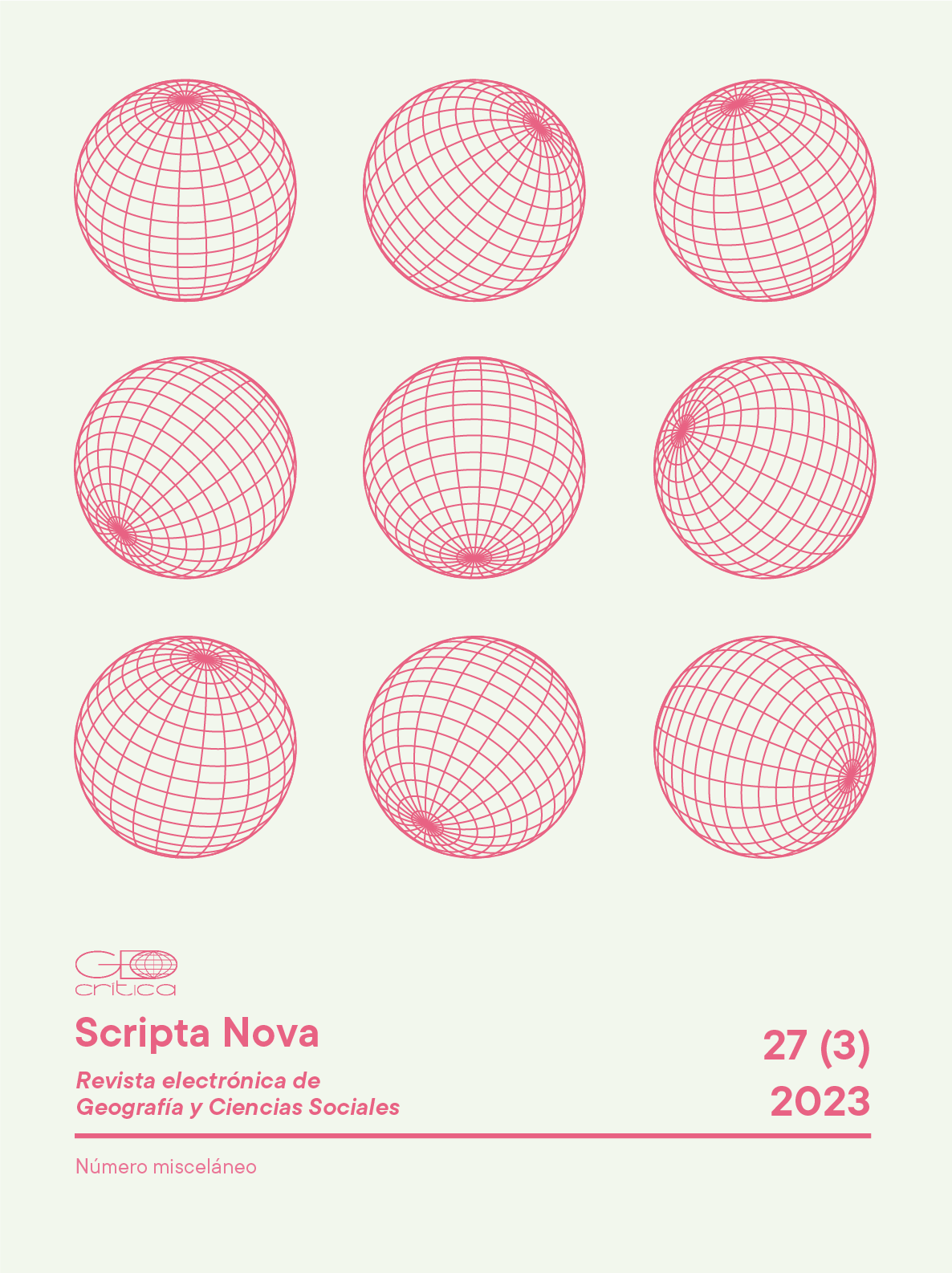SOCIAL SEGREGATION AND PUBLIC SCHOOL POLICY IN SEVILLE IN THE FIRST THIRD OF THE TWENTIETH CENTURY
DOI:
https://doi.org/10.1344/sn2023.27.40629Keywords:
Segregation, integration, literacy, school policy, SevilleAbstract
The main aim of the paper is to analyze the dynamics of social distribution throughout the urban space of Seville at the first third of the twentieth century. Integration-segregation issues that will help us to understand social geography of the city in later decades. In addition the role of different discourses and strategies of organization of the urban space will be considered. Specifically, the result of literacy policies and the particularities of school promotion. The article is structured in (1) sources and methodology, (2) introduction to the society of Seville in the period 1900-1935, (3) analysis of social-spatial integration-segregation in the city and (4) dynamics of literacy and school promotion. The last two issues are discussed both in terms of spatial patterns and detailed examples.
References
Almuedo Palma, José. 1996. Ciudad e industria: Sevilla 1950-1930. Sevilla: Diputación de Sevilla.
Almuedo Palma, José. 2016. “Un fracaso del modelo liberal. La enseñanza primaria y la escuela sevillana desde 1857 a 1936”, Clio: History and History Teaching 47: 1-126.
Arenas Posadas, Carlos. 2016. Poder, economía y sociedad en el sur. Historia de las instituciones del capitalismo andaluz. Sevilla: Junta de Andalucía.
Bourdieu, Pierre. 2012. La distinción. Madrid: Taurus.
Bowman, Mary Jane y Anderson, C. Arnold. 1963. “Concerning the Role of Education in Development”. En Old societies and New States, editado por Clifford Geertz, 247-279. Nueva York: Free Press.
Briggs, Xavier de Souza. 2001. “Ties that bind, bridge and constrain: Social capital and segregation in the American metropolis”, presentado en International Seminar on Segregation and the City. Cambridge.
Capel Sáez, Horacio. 2002. La morfología de las ciudades I. Barcelona: Serbal.
Carasa Soto, Pedro. 2001. “De la Burguesía a las Élites, entre la ambigüedad y la renovación conceptual”. Ayer 42, 213-239.
Fernández Salinas, Víctor. 2015. “Urbanismo y transformación de la ciudad histórica andaluza”. En Urbanización, modernización y cambio social en la Andalucía contemporánea, coordinado por David Martínez López, 79-100. Sevilla: Fundación Pública Andaluza, Centro de Estudios Andaluces, Junta de Andalucía.
González Dorado, Antonio. 1975 (2001). Sevilla: Centralidad Regional, Organización Interna de su Espacio. Sevilla: Ayuntamiento de Sevilla.
Greif, Avner y Laitin, David D. 2004. “A Theory of Endogenous Institutional Change”. American Political Science 4, 633-652.
Harris, Richard y Lewis, Robert. 1998). “Constructing a Fault (y) Zone: Misrepresentations of America Cities and Suburbs, 1900-1950”. Annals of the American Geographers 88, 4, 622-639.
Harris, Richard. y Macmanus, Ruth (eds). 1999. Chaning Suburbs. Fundation, Form and Function, London: E&FN Spon.
Marín Parra, Vicenta. 2012. La educación en Ceuta: 1912-1956. Ceuta: Ciudad Autónoma de Ceuta.
Martori, Joan Carles, Hoberg, Karen y Surinach, Jordi. 2006. “Población inmigrante y espacio urbano: Indicadores de segregación y pautas de localización”. EURE (Santiago) 32(97), 49-62. https://dx.doi.org/10.4067/S0250-71612006000300004
De Miguel Salanova, Santiago. 2013 “Bajo los tejados de Madrid. Segregación residencial en el primer tercio del siglo XX”. En I Congresso Histórico Internacional As ciudades na história: Populaçao, Vol. IV, pp. 239-263. Guimarães: Câmara Municipal de Guimarães.
Nicholas, Stephen. 1993. “Alfabetización y revolución industrial en Inglaterra”. En La maldición divina. Ignorancia t atraso económica en perspectiva histórica, editado por Clara Eugenia Núñez y Gabriel Tortella, 91-118. Madrid: Alianza Universidad.
Núñez, Clara Eugenia. 1997. “La educación como fuente de crecimiento”. Papeles de Economía 73, 213-242.
Oyón, José Luis; Maldonado, José y Griful, Eulàlia. 2001. Barcelona 1930: un atlas social. Barcelona: Universidad Politécnica de Barcelona.
Ruiz De Loizaga Vélez, Maite. 2011. “Capital humano y revolución social. Educación y desarrollo el Bilbao (1876-1920)”. Revista de Demografía Histórica 29 (1), 131-162.
Sewell, William H. 1996. “Historical events as transformations of structures: Inventing revolution at the Bastille”. Theory and Society 25, 841–881. https://doi.org/10.1007/BF00159818
Teulings, Coen Y Thijs, van Rens. 2006. “Education, Growth and Income Inequality”. The Review of Economics and Statistics 90(1), 89-104.
Van Leeuwen, Marco H. D.; Mass, Ineke y Miles, Andrew. 2002. HISCO. Historical International Standard Classification of Occupations. Leuven: Leuven University Press.
Vergara-Erices, Luis y Garín Contreras, Alan. 2016). “Vivienda social y segregación socioespacial en una ciudad pequeña: el caso de Angol, Chile”. Polis, 44. http://journals.openedition.org/polis/12006.
Viñao Frago, Antonio. 2004. Escuela para todos. Educación y modernidad en la España del siglo XX. Madrid: Marcial Pons.
Downloads
Published
Issue
Section
License
Copyright (c) 2023 José Almuedo Palma, Antonio García García

This work is licensed under a Creative Commons Attribution 4.0 International License.
Los autores que publican en esta revista están de acuerdo con los siguientes términos:
- Los autores conservan los derechos de autoría y otorgan a la revista el derecho de primera publicación, cin la obra disponible simultáneamente bajo una Licéncia de Atribución Compartir igual de Creative Commons que permite compartir la obra con terceros, siempre que estos reconozcan la autoría y la publicación inicial en esta revista.
- Los autores son libres de realizar acuerdos contractuales adicionales independientes para la distribución no exclusiva de la versió de la obra publicada en la revista (com por ejemplo la publicación en un repositorio institucional o en un libro), siempre que se reconozca la publicación inicial en esta revista.





